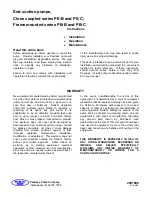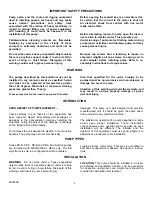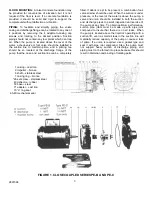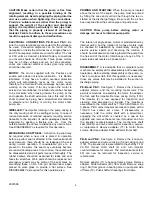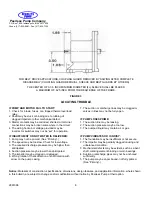
CAUTION Make certain that the pump is free from
alignment, resulting in a possible binding of the
rotating element. Avoid springing the piping into line
and use caution when tightening the connections.
Provide a suitable means (other than the pump) to
support the weight of the suction and discharge
piping. It is important, particularly in new pipe lines,
that the piping is properly cleaned of all foreign
material. Failure to adhere to these precautions can
result in equipment damage and malfunction.
ELECTRICAL CONNECTIONS PE-B and PE-C:
Be
sure the motor terminals are connected for the voltage to
be used. Connection diagrams can be found on the
nameplate or inside the terminal cover. Single phase, ¼
and 1/3 horsepower motors are wired for either 115 volts
or 230 volts as desired; standard factory connections
you receive should be 230 volts. Three phase motors
may be of other voltage and are not pre-connected.
Local and national electrical codes governing wiring
should be observed.
MOTOR:
The motor supplied with the Peerless end
suction pump does not require lubrication – it is lifetime
lubricated. It may have a build-in overload protection
which will automatically reset as the motor cools,
therefore, the main switch should always be open when
working on the motor. If for any reason the motor is
serviced or reconditioned, its rotation should be checked
to be clockwise when looking toward the pump at the
end opposite the shaft extension. Also, this end of the
shaft, covered by a plug, has a screwdriver slot referred
to elsewhere for holding or turning the motor shaft,
pump, etc.
IMPELLER:
The impeller rotating in the pump casing is
the only moving part of a centrifugal pump. In case of
reduced pressure or reduced capacity requiring service
traceable to the impeller, its water passages should be
inspected by passing a flexible wire, etc., from the
outside toward the center to dislodge any obstructions.
See DISASSEMBLY as required for this operation.
MECHANICAL SHAFT SEAL:
A short run-in period may
be required when a new unit is placed in operation
before a perfect seal is effected in the mechanical shaft
seal. However, there should be no leakage at the seal
during normal operation. If considerable grit, etc., is
present in the water, the seal may eventually become
scored and develop a leak. In such case, the seal should
be disassembled and all parts cleaned thoroughly. The
rubber bellows should be examined for leaks and seal
faces for scratches. Worn parts should be replaced, but
emergency repairs may be made of the seal faces by
smoothing these on No. 500 grit Carborundum paper
placed on plate glass to provide a flat surface. See
DISASSEMBLY as required for this operation also.
2891096
PRIMING AND STARTING:
When the pump is located
above the level of the liquid , the pump must be primed
by filling the case and suction line through the tee in-
stalled at the discharge flange. Be sure all the air has
been expelled from the suction pipe and pump case.
CAUTION Prime pump before starting motor or
damage can occur to internal pump parts.
The rotation of single phase motors is predetermined by
internal wiring, but the rotation of 3-phase motors must
be checked at installation by momentarily closing the
electric service switch and observing the rotation. It
should be clockwise when looking toward the pump from
the free end of the motor. Interchange of any 2 of the 3
power leads will reverse a 3 phase motor.
DISASSEMBLY:
It is advisable that a competent pump
mechanic be employed for disassembly and reassembly
operations. Before starting disassembly or the pump, re-
check to make certain that this operation is necessary.
Close any valves that may be installed in the suction or
discharge piping.
PE-B and PE-C:
See figure 1. Remove the 4 case-to-
adapter screws and the mounting foot-screws. This
permits removal as an assembly the motor, the adapter,
the foot, and the impeller. Remove casing O-ring (130).
The impeller (2) is now exposed for inspection and
cleaning. See paragraph on impeller. The impeller is
assembled to the motor shaft by 7/16-20 RH thread. On
3-phase, PE-C units, impellers are locked in place with a
7/16-20 hex socket set screw. If disassembly is
necessary, hold the motor shaft with a screwdriver,
engaging the slot which is covered by a cap at the
opposite end, remove the set screw, if provided, and turn
the impeller counterclockwise. The mechanical shaft
seal (65-80) can now be removed for inspection, service,
or replacement. Remove adapter (71) to motor frame
screws. Remove adapter. Slide deflector from shaft.
PB-B and PB-C:
See figure 2. Remove the 4 case-to-
adapter screws and remove casing (1) and casing O-ring
(130). The impeller (2) is assembled to the shaft by 7/16-
20 RH thread. Hold shaft (6) and turn impeller
counterclockwise for removal. The mechanical seal (65-
80) can now be removed for inspection, service or
replacement.
Remove adapter (71) to bearing frame screws. Remove
adapter. Slide deflector (40) from shaft. Remove snap
ring (16A) from groove in bearing bore on pump end side
of frame (19). Push shaft with bearings from frame.
4

